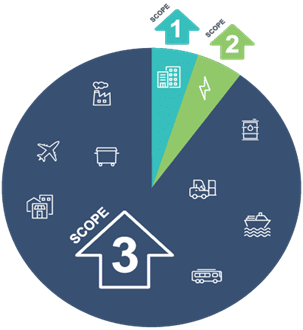Understanding the Three Scopes of Carbon Emissions: An ESG Perspective

The Complexities of Calculating Scope 3 Emissions
The main challenge in calculating Scope 3 emissions lies in the large umbrella and diversity of activities covered. Unlike Scope 1 and Scope 2, which rely on data which is controlled or directly influenced by the company, Scope 3 emissions require detailed information from a wide range of external sources. This can include suppliers, customers, transportation providers, and waste handlers.
Some Key Challenges in Scope 3 Emission Calculations:
- Data Availability and Quality: Suppliers often don’t bother to track their emissions or may use inconsistent reporting methods, leading to increased difficulty in gathering accurate data from the entire value chain, especially with more moving parts. Additionally, smaller suppliers may even lack the necessary resources or expertise to accurately report their emissions.
- Complex Supply Chains: At the peak of globalization, supply chains have never been more complex, and usually involve an unnecessarily large amount of tiers of suppliers. Going deeper into this supply chain leads to increased difficulty in obtaining reliable data, and often requires an unattainable level of collaboration and transparency, from everyone involved. In todays corporate landscape unfortunately, this is too good to be true.
- Estimation and Assumptions: As a half-hearted attempt to provide some sort of amount, companies will often rely on estimation methods as well as industry averages in order to calculate their Scope 3. While these estimations might be a good starting point to tackle this complex Scope, they almost never accurately reflect the true carbon impact of a companies activities or products.
- Double Counting Risks: Because Scope 3 emissions overlap with other companies' Scope 1 and Scope 2 emissions, there is a risk of double counting. For example, the emissions from a purchased product might be reported both by the manufacturer (Scope 1) and the buyer (Scope 3), leading to even further inaccuracies. Clear reporting standards and guidance from frameworks like the Greenhouse Gas Protocol are essential to avoid such issues.
- Dynamic Nature of Scope 3 Emissions: Unlike direct emissions, which tend to be more stable, Scope 3 emissions can fluctuate significantly based on changes in supply chain operations, shifts in consumer behaviour, and variations in product usage patterns. This dynamic nature adds to the difficulty of consistent and accurate reporting.
The Path Forward: Addressing Scope 3 Emissions
Despite the plethora of complexities we’ve outlines, addressing Scope 3 emissions is imperative for businesses aiming to meet their climate goals and align with stakeholder expectations. While it seems discouraging, fret not! Companies can take several steps to improve their Scope 3 emissions reporting and reduction efforts:
- Engaging with Suppliers: Building strong relationships with suppliers and encouraging them to track and report their emissions can help improve data accuracy and foster shared accountability for climate action.
- Implement Sustainable Procurement Practices: Prioritizing suppliers with robust sustainability credentials can help reduce upstream emissions, tackling the problem from its source.
- Investing in Technology and Data Analytics: Leveraging digital tools, such as carbon accounting software and blockchain technology, can enhance transparency and streamline emissions data collection.
Conclusion
Understanding and managing carbon emissions across all three scopes is a vital component of any robust ESG strategy. While Scope 1 and Scope 2 emissions are relatively easier to quantify and control, Scope 3 emissions represent the most significant challenge due to their indirect and complex nature. By actively engaging with stakeholders across the value chain, leveraging advanced technologies, and committing to transparency, companies can make meaningful progress in reducing their overall carbon footprint and contribute to a more sustainable future.
For businesses serious about their ESG performance, tackling Scope 3 emissions is not just an option—it’s a necessity. It may be a daunting task, but it is also an opportunity to drive innovation, build resilience, and create long-term value for both the company and the planet.
How Can My Company Improve Sustainability and ESG?
Here at NBS factory, your reputation matters. We're committed to sustainable practices backed by science. We understand the value of ESG and how to help with these challenges by DIAGNOSING your branding, MONITORING your reputation, AVOIDING legal risks, and MEASURING engagement.
The clock is ticking and there's no time for BS 😅 Start your journey to ESG excellence with a single step; we're here to support you. Send us an email now hello@nbs-factory.com or click here 👉 to request a demo
FAQ's
1. What are Scope 1 emissions?
Scope 1 emissions are direct greenhouse gas emissions from sources that a company owns or controls. This includes emissions from on-site fuel combustion, company-owned vehicles, and industrial processes.
2. How do Scope 2 emissions differ from Scope 1?
Scope 2 emissions are indirect emissions resulting from the generation of purchased energy, such as electricity, heating, and cooling, consumed by the company. While these emissions occur off-site, they are directly linked to the company's energy consumption.
3. What challenges are associated with measuring Scope 3 emissions?
Scope 3 emissions encompass all other indirect emissions that occur in a company's value chain, both upstream and downstream. Measuring these emissions is challenging due to their broad scope, involving numerous external partners and activities beyond the company's direct control.











